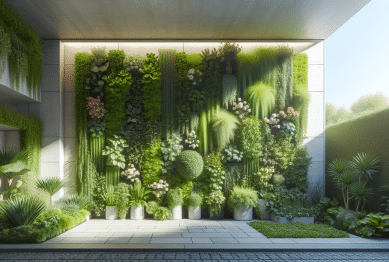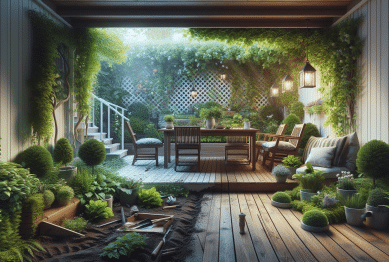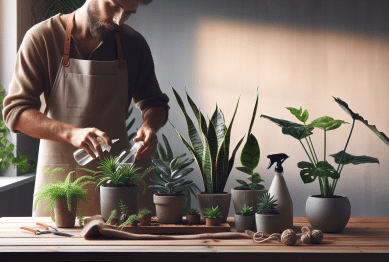Discover how vertical gardens redefine the concept of indoor and outdoor living. This guide explores creative ways to maximize limited space, boost air quality, and bring lush greenery into any home environment using vertical gardening techniques.
Why Vertical Gardens Appeal to Modern Homeowners
Vertical gardens have captured the imagination of homeowners seeking practical ways to bring nature into apartments, condos, and homes with limited floor area. They offer creative solutions for both indoor and outdoor living spaces, utilizing unused walls, balconies, or fences. Adopting vertical gardening not only creates a lush, green environment but also adds an appealing design feature that feels both modern and timeless. With an increasing focus on sustainability and optimizing small spaces, the popularity of vertical gardens continues to grow among urban dwellers and suburban families alike.
For many city residents, space is a precious commodity. Traditional gardens take up square footage that simply doesn’t exist in compact homes or apartments, but vertical gardening changes this dynamic completely. These living walls serve as natural art installations, enhancing aesthetics without compacting living areas. Their adaptability means you can tailor them to fit individual tastes, whether your style is minimalist or eclectic. This versatile approach to growing plants can transform bare exteriors and even invigorate interior spaces when sunlight or airflow is limited.
Apart from visual appeal, vertical gardens address a growing need for improved indoor air quality. Many plants are effective air purifiers. They help to filter toxins while introducing beneficial humidity indoors. This additional function is especially relevant as more people spend time inside, seeking healthier environments at home and at work. Ultimately, the allure of vertical gardening lies in its ability to deliver beauty, function, and well-being—benefits that homeowners increasingly desire in modern living spaces. (Source: https://www.epa.gov/indoor-air-quality-iaq/indoor-air-pollution-topic-index)
Creative Systems for Every Home: From DIY to Modular Kits
Exploring systems for vertical gardens, homeowners face choices ranging from do-it-yourself setups to modular kits readily available in garden centers. DIY vertical gardening can be as simple as repurposing pallets, hanging planters, or fabric pockets on a sturdy wall. This approach encourages creativity and often minimizes cost while allowing full control over the design and layout. For those with less time or who crave a more polished look, modular systems offer easy installation and maintenance with built-in irrigation and soil support. Many of these pre-designed options are adaptable to various plant types, including herbs, houseplants, and flowering species.
Choosing between a DIY vertical garden and a professional kit often depends on available resources, budget, and the desired scale of the greenery wall. Modular kits come with perks like water retention features, durable frames, and helpful instructions, streamlining the process. They’re especially popular in rental units where semi-permanent solutions are needed. DIY solutions foster deeper engagement in garden care, as the creator can select recycled materials and experiment with plant arrangements. Modular kits, on the other hand, support homeowners who prioritize efficiency, uniformity, or lack extensive gardening experience.
Support structures are essential for long-lasting vertical gardens. Whether using repurposed wood, wire frames, or high-quality plastic containers, the chosen infrastructure supports soil, water, and plant roots securely. Some advanced systems even feature self-watering technology, making maintenance simple for busy lifestyles. No matter the approach, ensuring proper light exposure and drainage plays a central role in the ongoing success of any vertical garden project. This level of flexibility means there is an option for every skill level, home size, and budget range. (Source: https://extension.psu.edu/vertical-gardening)
Plants That Thrive in Vertical Gardens
Selecting the right plants is crucial for the vibrancy and sustainability of any vertical garden. Hardy varieties like pothos, spider plants, philodendrons, and ferns are favorites for indoor installations. Outdoors, succulents, grasses, and trailing annuals perform beautifully on upright walls, especially in areas with varying sunlight. Picking low-maintenance, drought-tolerant species can also reduce overall upkeep. Many edible plants, such as herbs like basil, mint, and parsley, are well-suited for vertical growing, providing fresh flavors for meals while maximizing vertical real estate.
Match plant selection to specific light conditions in your chosen area. Shade-loving species work well in poorly lit rooms, while sun-seekers excel on bright balconies or patios. Indoor vertical gardens often benefit from foliage plants due to their air-purifying skills and minimal water needs. Outdoor gardens, meanwhile, embrace blooms and cascading vines that introduce variety and vivid color. Considerations like wind exposure, microclimate, and the garden’s accessibility will also influence which varieties thrive in your setup.
For those looking to add texture and layers, combining plants with various foliage types boosts the visual impact of a living wall. Mix creeping ground covers, tall upright shoots, and flowering plants in a staggered pattern for depth. Edible vertical gardens can focus on lettuce, strawberries, or even small peppers grown in rows. The delight of harvesting homegrown food from the wall or enjoying beautiful greenery indoors adds both pleasure and functionality to the modern home. (Source: https://hort.extension.wisc.edu/articles/vertical-gardening/)
Design Inspiration: Creating Striking Living Walls
Designing a vertical garden is a creative endeavor limited only by imagination and wall space. Modern living walls often serve as statement pieces, framing windows or doorways with lush plant life. Vertical herb gardens installed near kitchens bring both aroma and easy access for culinary creations. For outdoor patios, combining climbing vines and trailing flowers allows for seasonal displays that change throughout the year, turning ordinary fences or blank exteriors into vibrant, ever-changing murals.
Color plays an important role in vertical gardening design. Mix plants with green, burgundy, variegated, and flowering varieties to create stunning visual contrasts. Use geometric layouts or randomized patterns to suit personal style. Integrating lighting into vertical installations can highlight foliage and create magical nighttime ambiance. Combine living walls with water features or decorative pots for an even more dynamic effect. The versatility of this style ensures that each project is unique and personalized to the homeowner’s taste.
Many homeowners are now collaborating with landscape designers who specialize in green wall installations. This partnership brings professional guidance to placement, plant choices, and irrigation plans that guarantee longevity and ease of upkeep. However, even those on a budget can achieve eye-catching results by starting small and expanding over time. Lining a bathroom wall with moisture-loving species or organizing a sunroom display can dramatically improve energy and air quality throughout the home. (Source: https://www.rhs.org.uk/garden-inspiration/vertical-gardening)
Benefits Beyond Beauty: Health, Sustainability, and Wellbeing
Vertical gardens don’t just transform the visual ambience of a home—they also provide meaningful health and environmental advantages. Living walls contribute to improved air quality by absorbing carbon dioxide and producing oxygen, making indoor air fresher. Some research suggests that being surrounded by greenery can lower stress levels and boost mental well-being, creating peaceful retreats within urban environments. For families, a vertical garden can stimulate learning about plants, ecology, and nutrition, especially when edible species are included.
Sustainability is a core benefit of vertical gardening. These installations add vital green space in cities, helping to cool building exteriors and reduce energy costs linked to heating and cooling. Vertical gardens also act as insulation, regulating temperature and humidity indoors. Outdoor walls covered in vegetation provide new habitats for birds, bees, and beneficial insects, fostering healthy ecosystems and biodiversity even in concrete-heavy neighborhoods.
Water-saving strategies are integral to most modern vertical gardens. Built-in irrigation systems, moisture-retaining soil mixes, and plant choices tailored to climate effectively reduce water waste. This is critical for both environmental stewardship and long-term cost savings. Embracing vertical gardening as a lifestyle choice empowers homeowners to contribute positively to environmental health, all while enjoying a stylish, living feature that grows and evolves over time. (Source: https://www.sciencedirect.com/science/article/pii/S2212670816301245)
Caring for Your Vertical Garden: Maintenance Essentials
Proper maintenance is essential for ensuring the lush appearance and long-term health of vertical gardens. Regular watering, checking for soil moisture, and trimming overgrown plants keeps growth lush and controlled. Some living walls need drip irrigation or periodic misting, particularly in dry or air-conditioned environments. Compost or slow-release fertilizers can promote healthy foliage, while periodic inspections catch pests or diseases early, limiting potential damage.
Support structures also require attention. Make sure wall mounts, frames, and pots remain secure, especially for outdoor installations exposed to weather. Light pruning encourages new growth and prevents overcrowding, which can trigger mold or root rot. It’s also helpful to rotate plant positions occasionally, especially in indoor settings, to ensure even light distribution and prevent lanky growth. Monitor plant health consistently, and replace struggling specimens promptly to maintain a thriving ecosystem.
Maintenance grows easier with experience. As confidence builds, homeowners might choose to experiment with different plant species, artful layouts, or new irrigation solutions. Ongoing learning can come from local gardening clubs, cooperative extension programs, or online resources specializing in vertical gardening. Implementing routine care not only preserves the garden’s beauty but also fosters a rewarding, hands-on connection to nature within the home. (Source: https://extension.umn.edu/houseplants/vertical-gardens)
References
1. U.S. Environmental Protection Agency. (n.d.). Indoor Air Quality: Basic Information. Retrieved from https://www.epa.gov/indoor-air-quality-iaq/indoor-air-pollution-topic-index
2. PennState Extension. (n.d.). Vertical Gardening. Retrieved from https://extension.psu.edu/vertical-gardening
3. University of Wisconsin-Madison Division of Extension. (n.d.). Vertical Gardening. Retrieved from https://hort.extension.wisc.edu/articles/vertical-gardening/
4. Royal Horticultural Society. (n.d.). Vertical gardening: ideas to take your garden to new heights. Retrieved from https://www.rhs.org.uk/garden-inspiration/vertical-gardening
5. ScienceDirect. (2016). Vertical green walls: a sustainable solution for cities. Retrieved from https://www.sciencedirect.com/science/article/pii/S2212670816301245
6. University of Minnesota Extension. (n.d.). Vertical gardens for houseplants. Retrieved from https://extension.umn.edu/houseplants/vertical-gardens









